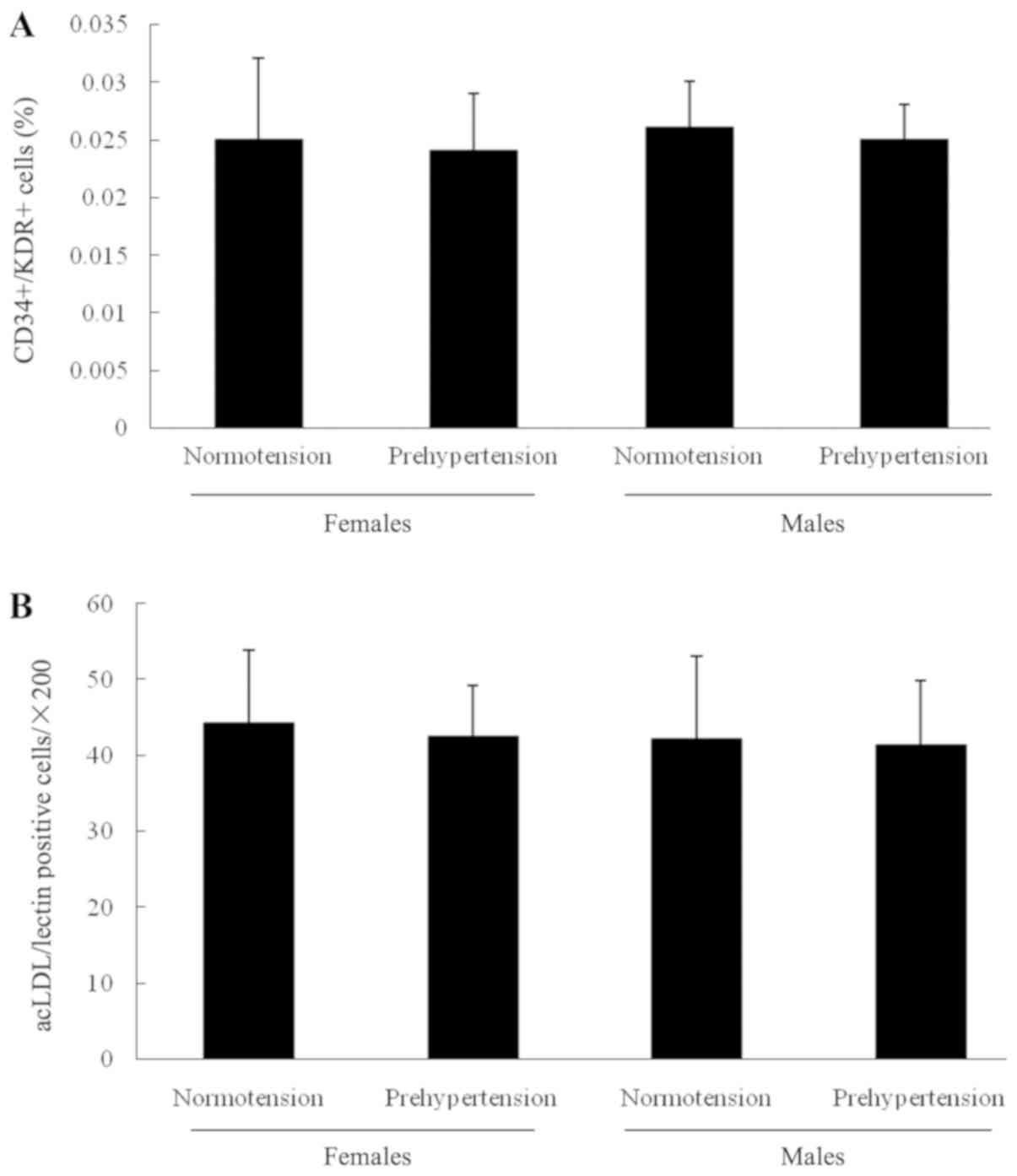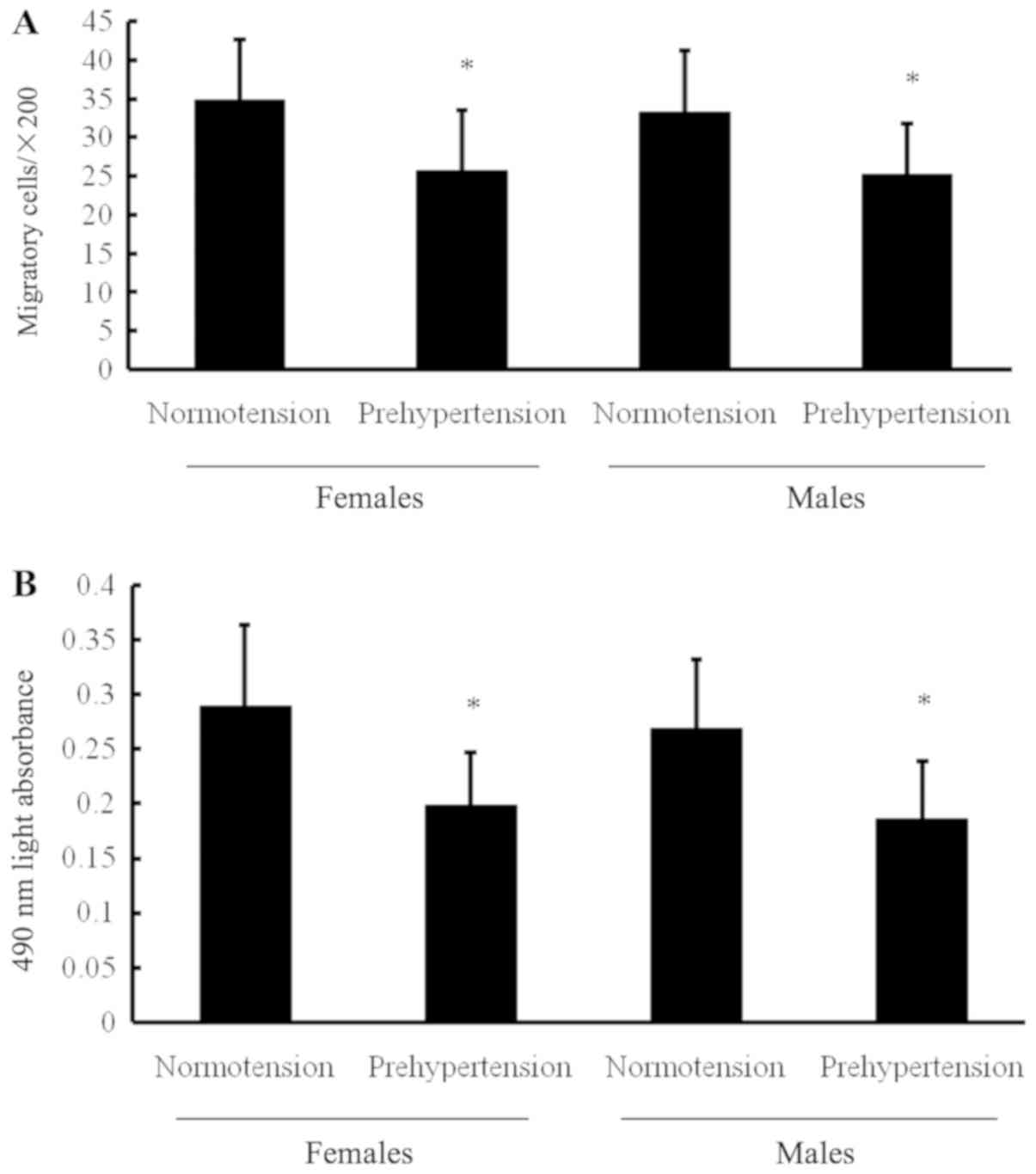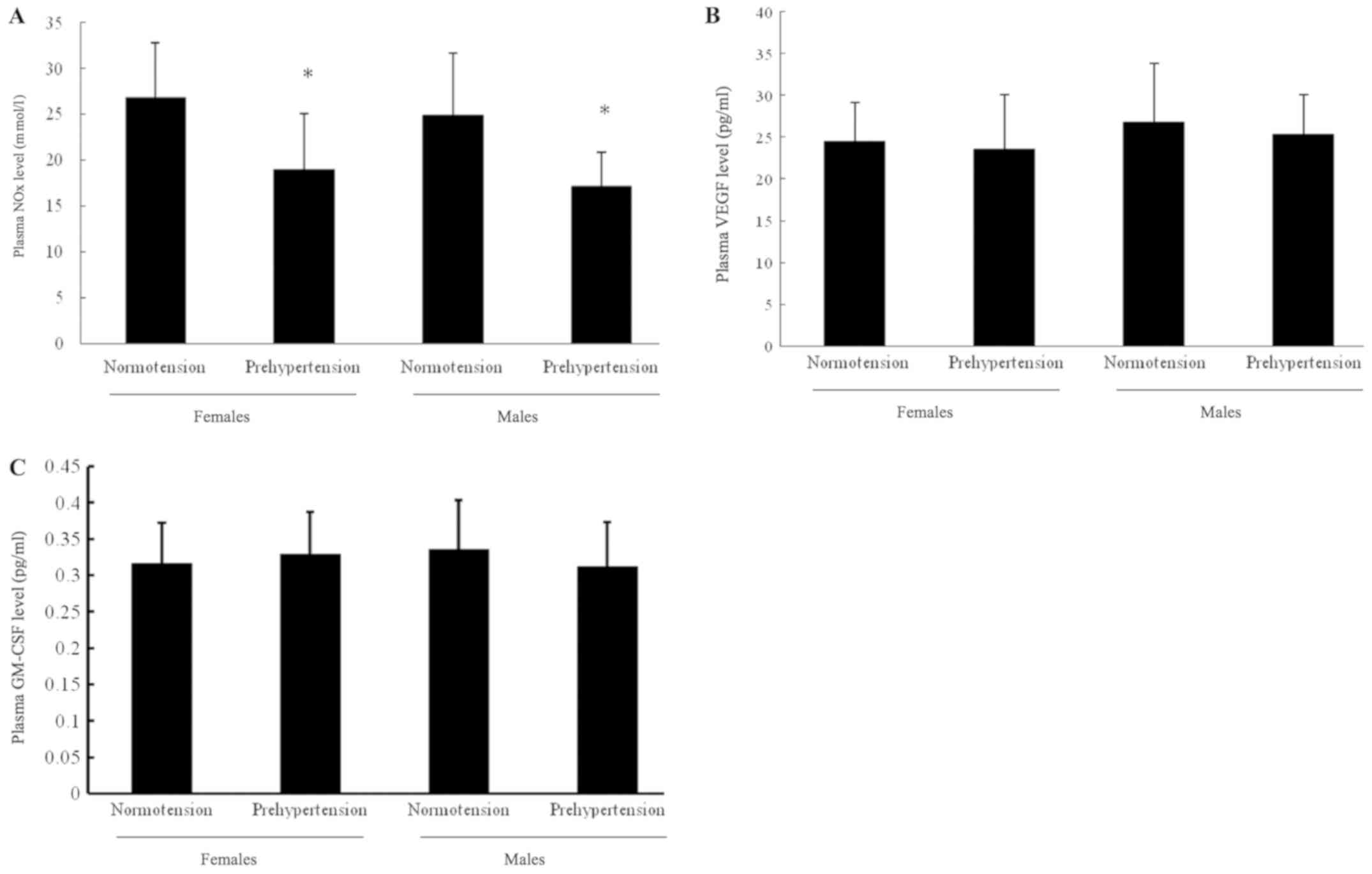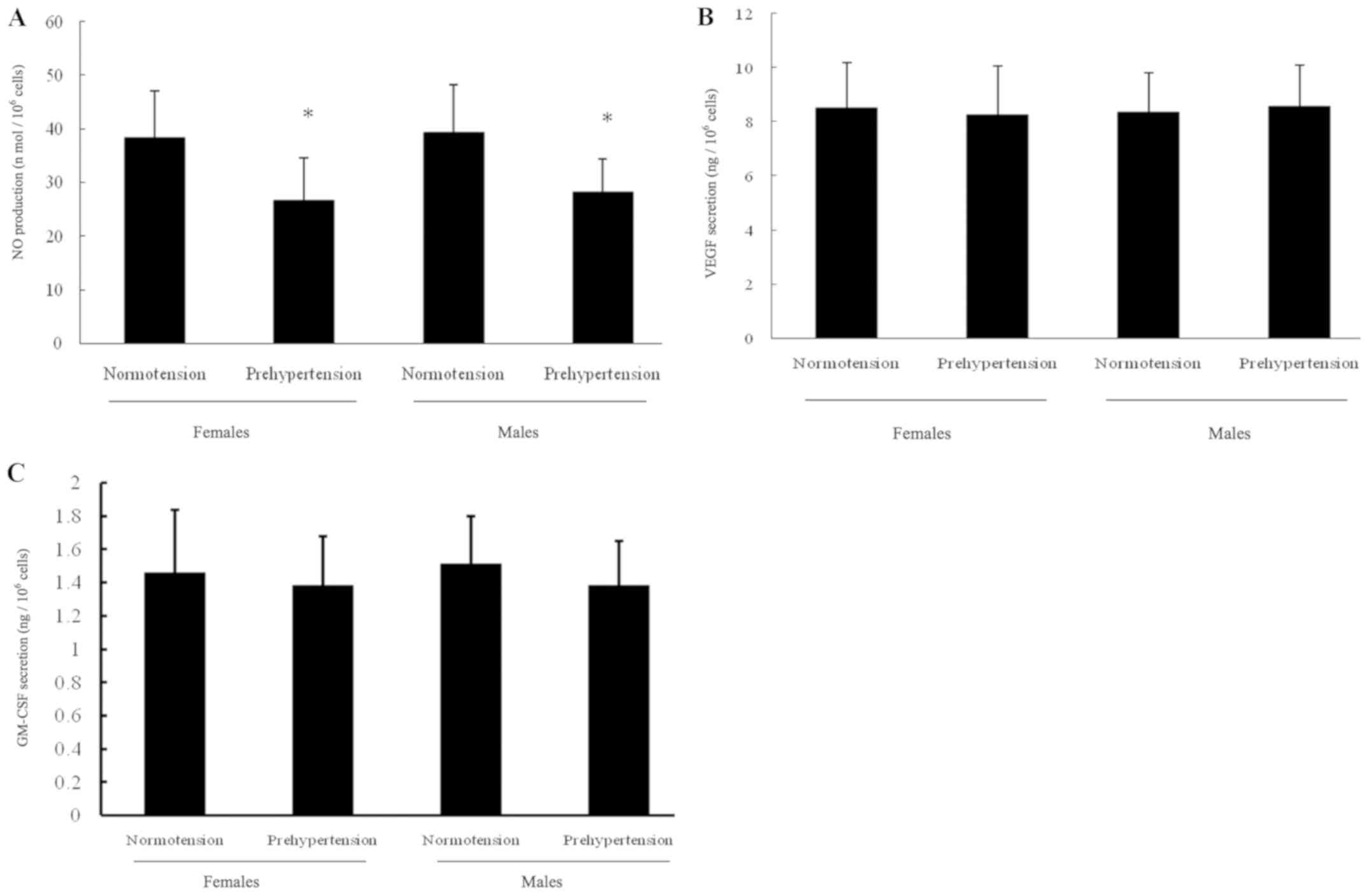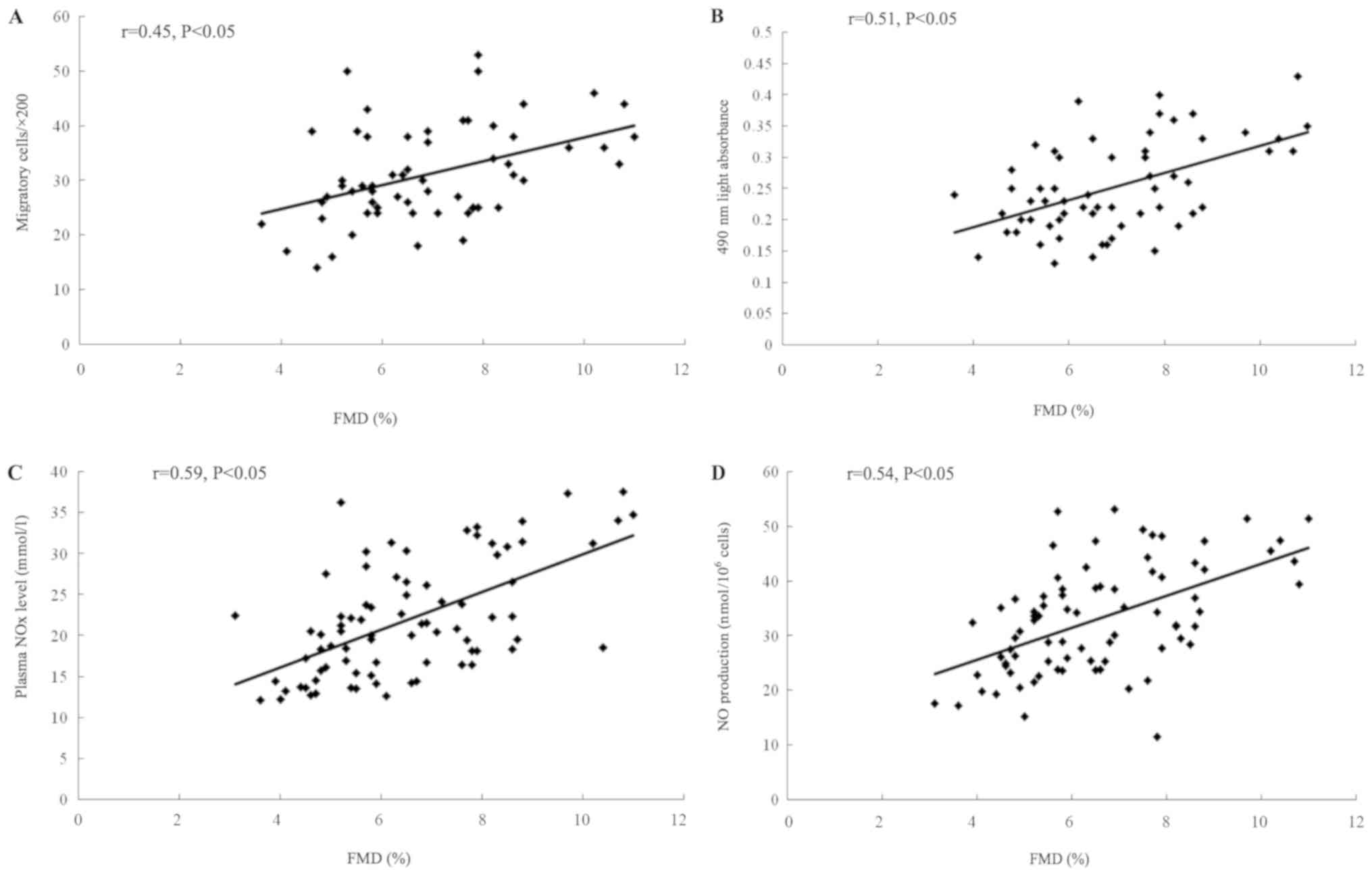|
1
|
Chobanian AV, Bakris GL, Black HR, Cushman
WC, Green LA, Izzo JL Jr, Jones DW, Materson BJ, Oparil S, Wright
JT Jr, et al: The seventh report of the joint national committee on
prevention, detection, evaluation, and treatment of high blood
pressure: The JNC 7 report. JAMA. 289:2560–2572. 2003. View Article : Google Scholar : PubMed/NCBI
|
|
2
|
Xue H, Wang J, Hou J, Li J, Gao J, Chen S,
Zhu H and Wu S: Prehypertension and chronic kidney disease in
chinese population: Four-year follow-up study. PLoS One.
10:e01444382015. View Article : Google Scholar : PubMed/NCBI
|
|
3
|
Bajpai JK, A P S, A K A, A K D, Garg B and
Goel A: Impact of prehypertension on left ventricular structure,
function and geometry. J Clin Diagn Res. 8:BC07–BC010.
2014.PubMed/NCBI
|
|
4
|
Navarro-Gonzalez JF, Mora C, Muros M,
Garcia J, Donate J and Cazana V: Relationship between inflammation
and microalbuminuria in prehypertension. J Hum Hypertens.
27:119–125. 2013. View Article : Google Scholar : PubMed/NCBI
|
|
5
|
Celik T, Yuksel UC, Fici F, Celik M, Yaman
H, Kilic S, Iyisoy A, Dell'oro R, Grassi G, Yokusoglu M and Mancia
G: Vascular inflammation and aortic stiffness relate to early left
ventricular diastolic dysfunction in prehypertension. Blood Press.
22:94–100. 2013. View Article : Google Scholar : PubMed/NCBI
|
|
6
|
Huang Y, Wang S, Cai X, Mai W, Hu Y, Tang
H and Xu D: Prehypertension and incidence of cardiovascular
disease: A meta-analysis. BMC Med. 11:1772013. View Article : Google Scholar : PubMed/NCBI
|
|
7
|
Vasan RS, Larson MG, Leip EP, Evans JC,
O'Donnell CJ, Kannel WB and Levy D: Impact of high-normal blood
pressure on the risk of cardiovascular disease. N Engl J Med.
345:1291–1297. 2001. View Article : Google Scholar : PubMed/NCBI
|
|
8
|
Vasan RS, Larson MG, Leip EP, Kannel WB
and Levy D: Assessment of frequency of progression to hypertension
in non-hypertensive participants in the framingham heart study: A
cohort study. Lancet. 358:1682–1686. 2001. View Article : Google Scholar : PubMed/NCBI
|
|
9
|
Schlaich MP, Parnell MM, Ahlers BA, Finch
S, Marshall T, Zhang WZ and Kaye DM: Impaired L-arginine transport
and endothelial function in hypertensive and genetically
predisposed normotensive subjects. Circulation. 110:3680–3686.
2004. View Article : Google Scholar : PubMed/NCBI
|
|
10
|
Taddei S, Virdis A, Mattei P, Ghiadoni L,
Sudano I and Salvetti A: Defective L-arginine-nitric oxide pathway
in offspring of essential hypertensive patients. Circulation.
94:1298–1303. 1996. View Article : Google Scholar : PubMed/NCBI
|
|
11
|
Giannotti G, Doerries C, Mocharla PS,
Mueller MF, Bahlmann FH, Horvath T, Jiang H, Sorrentino SA,
Steenken N, Manes C, et al: Impaired endothelial repair capacity of
early endothelial progenitor cells in prehypertension: Relation to
endothelial dysfunction. Hypertension. 55:1389–1397. 2010.
View Article : Google Scholar : PubMed/NCBI
|
|
12
|
Aicher A, Zeiher AM and Dimmeler S:
Mobilizing endothelial progenitor cells. Hypertension. 45:321–325.
2005. View Article : Google Scholar : PubMed/NCBI
|
|
13
|
Hill JM, Zalos G, Halcox JP, Schenke WH,
Waclawiw MA, Quyyumi AA and Finkel T: Circulating endothelial
progenitor cells, vascular function, and cardiovascular risk. N
Engl J Med. 348:593–600. 2003. View Article : Google Scholar : PubMed/NCBI
|
|
14
|
MacEneaney OJ, DeSouza CA, Weil BR,
Kushner EJ, Van Guilder GP, Mestek ML, Greiner JJ and Stauffer BL:
Prehypertension and endothelial progenitor cell function. J Hum
Hypertens. 25:57–62. 2011. View Article : Google Scholar : PubMed/NCBI
|
|
15
|
Moreau KL, Hildreth KL, Meditz AL, Deane
KD and Kohrt WM: Endothelial function is impaired across the stages
of the menopause transition in healthy women. J Clin Endocrinol
Metab. 97:4692–4700. 2012. View Article : Google Scholar : PubMed/NCBI
|
|
16
|
Gavin KM, Seals DR, Silver AE and Moreau
KL: Vascular endothelial estrogen receptor alpha is modulated by
estrogen status and related to endothelial function and endothelial
nitric oxide synthase in healthy women. J Clin Endocrinol Metab.
94:3513–3520. 2009. View Article : Google Scholar : PubMed/NCBI
|
|
17
|
Denton KM, Hilliard LM and Tare M:
Sex-related differences in hypertension: Seek and ye shall find.
Hypertension. 62:674–677. 2013. View Article : Google Scholar : PubMed/NCBI
|
|
18
|
Taddei S, Virdis A, Ghiadoni L, Mattei P,
Sudano I, Bernini G, Pinto S and Salvetti A: Menopause is
associated with endothelial dysfunction in women. Hypertension.
28:576–582. 1996. View Article : Google Scholar : PubMed/NCBI
|
|
19
|
Rudzitis-Auth J, Nenicu A, Nickels RM,
Menger MD and Laschke MW: Estrogen stimulates homing of endothelial
progenitor cells to endometriotic lesions. Am J Pathol.
186:2129–2142. 2016. View Article : Google Scholar : PubMed/NCBI
|
|
20
|
Zhen Y, Xiao S, Ren Z, Shen HW, Su H, Tang
YB and Zeng H: Increased endothelial progenitor cells and nitric
oxide in young prehypertensive women. J Clin Hypertens (Greenwich).
17:298–305. 2015. View Article : Google Scholar : PubMed/NCBI
|
|
21
|
Asahara T, Takahashi T, Masuda H, Kalka C,
Chen D, Iwaguro H, Inai Y, Silver M and Isner JM: VEGF contributes
to postnatal neovascularization by mobilizing bone marrow-derived
endothelial progenitor cells. EMBO J. 18:3964–3972. 1999.
View Article : Google Scholar : PubMed/NCBI
|
|
22
|
Duda DG, Fukumura D and Jain RK: Role of
eNOS in neovascularization: NO for endothelial progenitor cells.
Trends Mol Med. 10:143–145. 2004. View Article : Google Scholar : PubMed/NCBI
|
|
23
|
Powell TM, Paul JD, Hill JM, Thompson M,
Benjamin M, Rodrigo M, McCoy JP, Read EJ, Khuu HM, Leitman SF, et
al: Granulocyte colony-stimulating factor mobilizes functional
endothelial progenitor cells in patients with coronary artery
disease. Arterioscler Thromb Vasc Biol. 25:296–301. 2005.
View Article : Google Scholar : PubMed/NCBI
|
|
24
|
Yang Z, Wang JM, Chen L, Luo CF, Tang AL
and Tao J: Acute exercise-induced nitric oxide production
contributes to upregulation of circulating endothelial progenitor
cells in healthy subjects. J Hum Hypertens. 21:452–460. 2007.
View Article : Google Scholar : PubMed/NCBI
|
|
25
|
James PA, Oparil S, Carter BL, Cushman WC,
Dennison-Himmelfarb C, Handler J, Lackland DT, LeFevre ML,
MacKenzie TD, Ogedegbe O, et al: 2014 evidence-based guideline for
the management of high blood pressure in adults: Report from the
panel members appointed to the Eighth Joint National Committee (JNC
8). JAMA. 311:507–520. 2014. View Article : Google Scholar : PubMed/NCBI
|
|
26
|
Vasa M, Fichtlscherer S, Aicher A, Adler
K, Urbich C, Martin H, Zeiher AM and Dimmeler S: Number and
migratory activity of circulating endothelial progenitor cells
inversely correlate with risk factors for coronary artery disease.
Circ Res. 89:E1–E7. 2001. View Article : Google Scholar : PubMed/NCBI
|
|
27
|
Yang Z, Chen L, Su C, Xia WH, Wang Y, Wang
JM, Chen F, Zhang YY, Wu F, Xu SY, et al: Impaired endothelial
progenitor cell activity is associated with reduced arterial
elasticity in patients with essential hypertension. Clin Exp
Hypertens. 32:444–452. 2010. View Article : Google Scholar : PubMed/NCBI
|
|
28
|
Yang Z, Xia WH, Su C, Wu F, Zhang YY, Xu
SY, Liu X, Zhang XY, Ou ZJ, Lai GH, et al: Regular exercise-induced
increased number and activity of circulating endothelial progenitor
cells attenuates age-related decline in arterial elasticity in
healthy men. Int J Cardiol. 165:247–254. 2013. View Article : Google Scholar : PubMed/NCBI
|
|
29
|
Yang Z, Xia WH, Zhang YY, Xu SY, Liu X,
Zhang XY, Yu BB, Qiu YX and Tao J: Shear stress-induced activation
of Tie2-dependent signaling pathway enhances reendothelialization
capacity of early endothelial progenitor cells. J Mol Cell Cardiol.
52:1155–1163. 2012. View Article : Google Scholar : PubMed/NCBI
|
|
30
|
Corretti MC, Anderson TJ, Benjamin EJ,
Celermajer D, Charbonneau F, Creager MA, Deanfield J, Drexler H,
Gerhard-Herman M, Herrington D, et al: Guidelines for the
ultrasound assessment of endothelial-dependent flow-mediated
vasodilation of the brachial artery: A report of the international
brachial artery reactivity task force. J Am Coll Cardiol.
39:257–265. 2002. View Article : Google Scholar : PubMed/NCBI
|
|
31
|
Sibal L, Aldibbiat A, Agarwal SC, Mitchell
G, Oates C, Razvi S, Weaver JU, Shaw JA and Home PD: Circulating
endothelial progenitor cells, endothelial function, carotid
intima-media thickness and circulating markers of endothelial
dysfunction in people with type 1 diabetes without macrovascular
disease or microalbuminuria. Diabetologia. 52:1464–1473. 2009.
View Article : Google Scholar : PubMed/NCBI
|
|
32
|
Lemieux C, Cloutier I and Tanguay JF:
Menstrual cycle influences endothelial progenitor cell regulation:
A link to gender differences in vascular protection? Int J Cardiol.
136:200–210. 2009. View Article : Google Scholar : PubMed/NCBI
|
|
33
|
Hoetzer GL, MacEneaney OJ, Irmiger HM,
Keith R, Van Guilder GP, Stauffer BL and DeSouza CA: Gender
differences in circulating endothelial progenitor cell
colony-forming capacity and migratory activity in middle-aged
adults. Am J Cardiol. 99:46–48. 2007. View Article : Google Scholar : PubMed/NCBI
|
|
34
|
Rousseau A, Ayoubi F, Deveaux C, Charbit
B, Delmau C, Christin-Maitre S, Jaillon P, Uzan G and Simon T:
Impact of age and gender interaction on circulating endothelial
progenitor cells in healthy subjects. Fertil Steril. 93:843–846.
2010. View Article : Google Scholar : PubMed/NCBI
|
|
35
|
Fadini GP, de Kreutzenberg S, Albiero M,
Coracina A, Pagnin E, Baesso I, Cignarella A, Bolego C, Plebani M,
Nardelli GB, et al: Gender differences in endothelial progenitor
cells and cardiovascular risk profile: The role of female
estrogens. Arterioscler Thromb Vasc Biol. 28:997–1004. 2008.
View Article : Google Scholar : PubMed/NCBI
|
|
36
|
Aicher A, Heeschen C and Dimmeler S: The
role of NOS3 in stem cell mobilization. Trends Mol Med. 10:421–425.
2004. View Article : Google Scholar : PubMed/NCBI
|
|
37
|
De Falco E, Carnevale R, Pagano F,
Chimenti I, Fianchini L, Bordin A, Siciliano C, Monticolo R,
Equitani F, Carrizzo A, et al: Role of NOX2 in mediating
doxorubicin-induced senescence in human endothelial progenitor
cells. Mech Ageing Dev. 159:37–43. 2016. View Article : Google Scholar : PubMed/NCBI
|
|
38
|
Aicher A, Heeschen C, Mildner-Rihm C,
Urbich C, Ihling C, Technau-Ihling K, Zeiher AM and Dimmeler S:
Essential role of endothelial nitric oxide synthase for
mobilization of stem and progenitor cells. Nat Med. 9:1370–1376.
2003. View Article : Google Scholar : PubMed/NCBI
|
|
39
|
Sorrentino SA, Bahlmann FH, Besler C,
Muller M, Schulz S, Kirchhoff N, Doerries C, Horvath T, Limbourg A,
Limbourg F, et al: Oxidant stress impairs in vivo
reendothelialization capacity of endothelial progenitor cells from
patients with type 2 diabetes mellitus: Restoration by the
peroxisome proliferator-activated receptor-gamma agonist
rosiglitazone. Circulation. 116:163–173. 2007. View Article : Google Scholar : PubMed/NCBI
|
|
40
|
Darkow DJ, Lu L and White RE: Estrogen
relaxation of coronary artery smooth muscle is mediated by nitric
oxide and cGMP. Am J Physiol. 272:H2765–H2773. 1997.PubMed/NCBI
|
|
41
|
Thompson J and Khalil RA: Gender
differences in the regulation of vascular tone. Clin Exp Pharmacol
Physiol. 30:1–15. 2003. View Article : Google Scholar : PubMed/NCBI
|
|
42
|
Iwakura A, Luedemann C, Shastry S, Hanley
A, Kearney M, Aikawa R, Isner JM, Asahara T and Losordo DW:
Estrogen-mediated, endothelial nitric oxide synthase-dependent
mobilization of bone marrow-derived endothelial progenitor cells
contributes to reendothelialization after arterial injury.
Circulation. 108:3115–3121. 2003. View Article : Google Scholar : PubMed/NCBI
|
|
43
|
Sumi D, Hayashi T, Jayachandran M and
Iguchi A: Estrogen prevents destabilization of endothelial nitric
oxide synthase mRNA induced by tumor necrosis factor alpha through
estrogen receptor mediated system. Life Sci. 69:1651–1660. 2001.
View Article : Google Scholar : PubMed/NCBI
|
|
44
|
Wagner AH, Schroeter MR and Hecker M:
17beta-estradiol inhibition of NADPH oxidase expression in human
endothelial cells. FASEB J. 15:2121–2130. 2001. View Article : Google Scholar : PubMed/NCBI
|
|
45
|
Hohmann N, Xia N, Steinkamp-Fenske K,
Forstermann U and Li H: Estrogen receptor signaling and the
PI3K/Akt pathway are involved in betulinic acid-induced eNOS
activation. Molecules. 21:E9732016. View Article : Google Scholar : PubMed/NCBI
|
|
46
|
Sobrino A, Vallejo S, Novella S,
Lázaro-Franco M, Mompeón A, Bueno-Betí C, Walther T, Sánchez-Ferrer
C, Peiró C and Hermenegildo C: Mas receptor is involved in the
estrogen-receptor induced nitric oxide-dependent vasorelaxation.
Biochem Pharmacol. 129:67–72. 2017. View Article : Google Scholar : PubMed/NCBI
|



